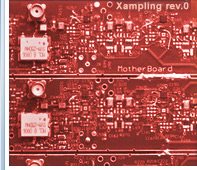 |
Xampling
Wideband Communication
From Theory to Hardware: Sub-Nyquist
Sampling of Sparse Wideband Analog Signals
Moshe Mishali and Yonina C. Eldar Introduction
Conventional sub-Nyquist sampling methods for analog
signals exploit prior information about the spectral
support. Here, we consider the challenging
problem of blind sub-Nyquist sampling of multiband
signals, whose unknown frequency support occupies only a
small portion of a wide spectrum. Our primary design
goals are efficient hardware implementation and low
computational load on the supporting digital processing.
We propose a system, named the modulated wideband
converter, which first multiplies the analog signal by a
bank of periodic waveforms. The product is then lowpass
filtered and sampled uniformly at a low rate, which is
orders of magnitude smaller than Nyquist. Perfect
recovery from the proposed samples is achieved under
certain necessary and sufficient conditions. We also
develop a digital architecture, which allows either
reconstruction of the analog input, or processing of any
band of interest at a low rate, that is, without
interpolating to the high Nyquist rate.
The MWC is useful in cognitive radio applications where opportunistic
users exploit temporarily vacant bands after detecting the
absence of activity of their owners. One of the crucial tasks
in cognitive radios is spectrum sensing and detection
which has to be precise and efficient. Yet, such radios typically deal
with wideband signals whose Nyquist rates are very high. Therefore, the MWC can be used as an enabler of cognitive radio technology offering a convenient and low rate solution to the spectrum sensing challenge. For more details on this application see here.
Signal Model
the input x(t) has multiband spectra with energy that concentrates on N frequency intervals of individual widths B located anywhere below some maximal frequency fmax.
Union of Spectrum Slices
Since each combination
of carrier frequencies determines a single subspace, a
multiband signal can be described in union terminology
by indexing the possible spectral supports with \lambda
and letting A_\lambda capture the signal content
on the chosen support. In principle, fi lies in the continuum [0,fmax]
in this modeling, so that the union contains infinitely
many subspaces. A different viewpoint is to divide the
Nyquist range to M slices and enumerate the
possible supports according to the slice indices that
contain signal energy. This approach results in a finite
union of bandpass subspaces.
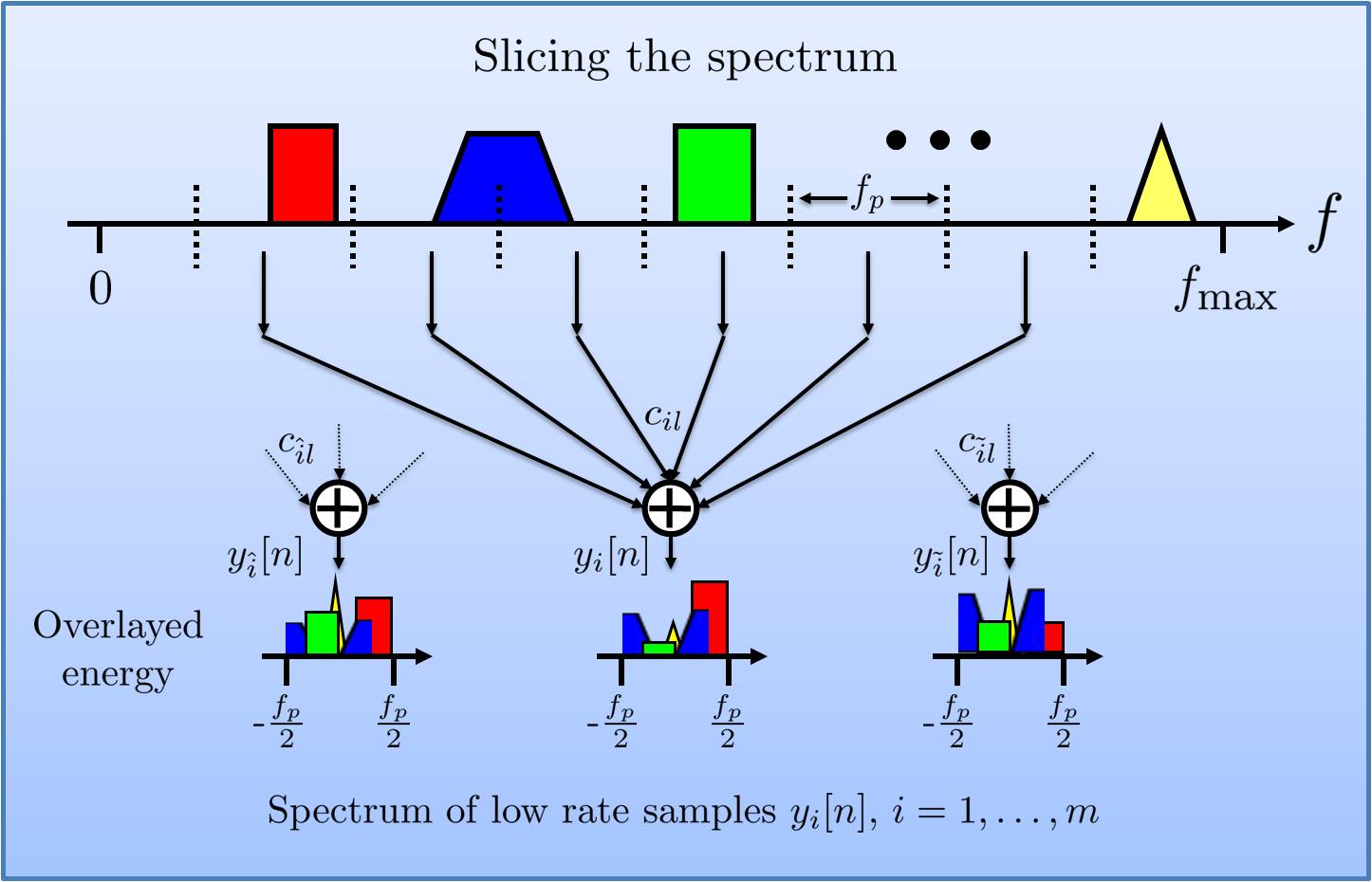
The approaches we describe below rely
on this viewpoint as follows. The acquisition stage
generates a set of sampling sequences yi[n],
such that each sequence is a linear mixture of spectrum
slices. The aliasing allows to reduce the bandwidth to a
narrow range of frequencies which can be sampled at a
low rate. The drawback of course is that the samples
contain aliased signal components. As we show, in the
digital domain we can resolve this ambiguity by suitable
processing. Mathematically, the aliasing is captured by the
following system of equations:
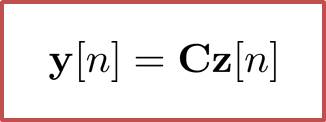
The vector y[n]
has length m, as the number of sampling sequences
that the hardware produces. The vector z[n]
has length M, with entries corresponding to the
spectrum slices. Typically, m<M so that the total
sampling rate is below Nyquist. The approaches below
realize this viewpoint using different analog
compression techniques. Recovery from y[n]
is described afterwards.
X-ADC via Periodic Nonuniform Sampling
Periodic nonuniform sampling is obtained by selecting a
sampling pattern of m points within an interval of
length MT, where T is the Nyquist
interval, and repeating this sampling pattern on
consecutive intervals of length MT.
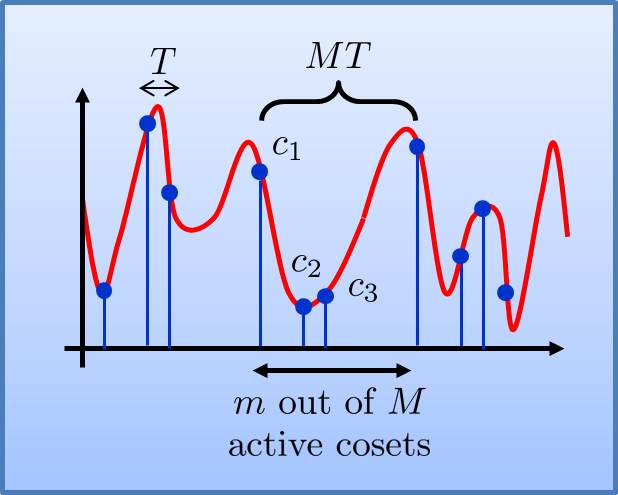
In this approach, we define yi[n]
for the uniform sequence corresponding to the sampling
points in shift ciT.
The sensing matrix C in this approach is a partial DFT matrix.
X-ADC via Modulated Wideband Converter
The input x(t) passes through RF processing front-end of m channels. In the ith channel, x(t) is multiplied by a periodic waveform p_i(t) with period T,
lowpass filtered by h(t) with cutoff 1/2T,
and then sampled at rate f_s=1/T.
The basic parameter setting is
m >= 4N, f_s= 1/T >= B.
An advanced configuration enables to collapse the number
of branches m by a factor of q at the expense of increasing the sampling rate of each
channel by the same factor, so that f_s=q/T but the overall sampling rate mf_s is unchanged. In principle, the advanced configuration
allows to collapse the MWC system to a single sampling
branch using q=m.
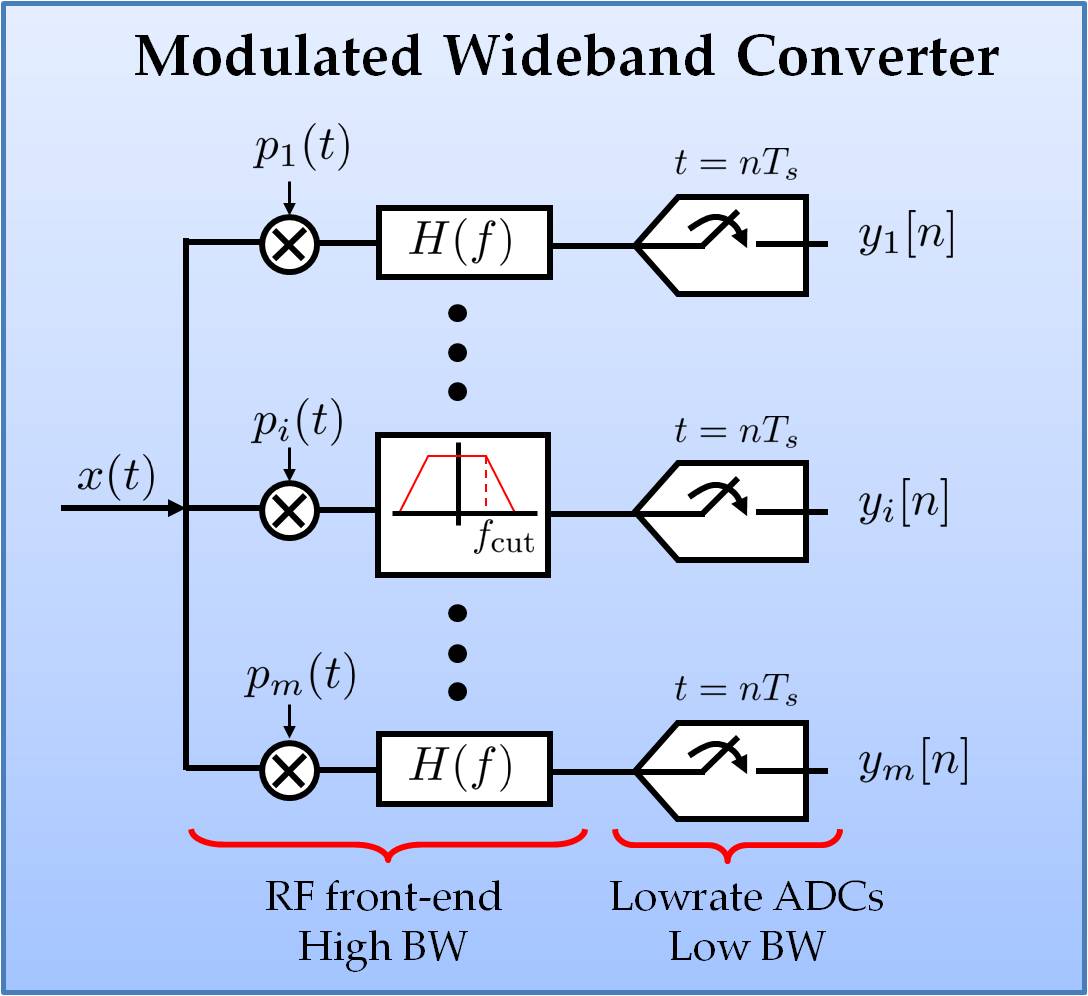
Since p_i(t) is
periodic, it has a Fourier expansion

In the frequency
domain, mixing by p_i(t) is tantamount to
convolution between the Fourier transform of x(t) and that of p_i(t). Thus, as before, the spectrum
is conceptually divided into slices of width
1/T, and a weighted-sum of these slices is
shifted to the origin. The lowpass filter h(t) transfers only the narrowband frequencies up to f_s/2 from that mixture to the output sequence y_i[n].
Subspace Detection: Continuous to Finite (CTF)
Block
An efficient subspace detection approach
is the continuous to finite (CTF) block depicted below.

The CTF recovers the
set of active bandpass slices as follows. First, it
constructs a matrix V from several (typically 2N) consecutive samples y[n], either by
direct stacking y[n] into the columns of V,
or via other simple computations that allows combating
noise. Then, it solves the following underdetermined
system V=CU, for the sparsest solution matrix,
namely U with minimal number of nonidentically-zero
rows. The indices of these nonzero rows are proven
to detect the set of active spectrum slices of
x(t).
Signal Reconstruction
Denoting by lambda the CTF
result, namely the set of active spectrum slices, the
signal is reconstructed in readtime by

where the H denotes conjugate
transpose, and subscripts are column/entry restrictions.
Standard DAC techniques reconstruct x(t) via
lowpass interpolation of z_l[n] and modulation to
the proper positions on the spectrum.
Hardware Design
The MWC has been implemented as a
board-level hardware prototype. The hardware
specifications cover inputs with 2 GHz Nyquist rate and NB=120 MHz spectrum occupation. The prototype has m=4 sampling branches, with total sampling rate
of 280 MHz, far below the 2 GHz Nyquist rate. In
order to save analog components, the hardware
realization incorporates the advanced configuration of
the MWC with a collapsing factor q=3. In
addition, a single shift-register provides a basic
periodic pattern, from which m periodic waveforms
are derived using delays, that is, by tapping m different locations of the register.
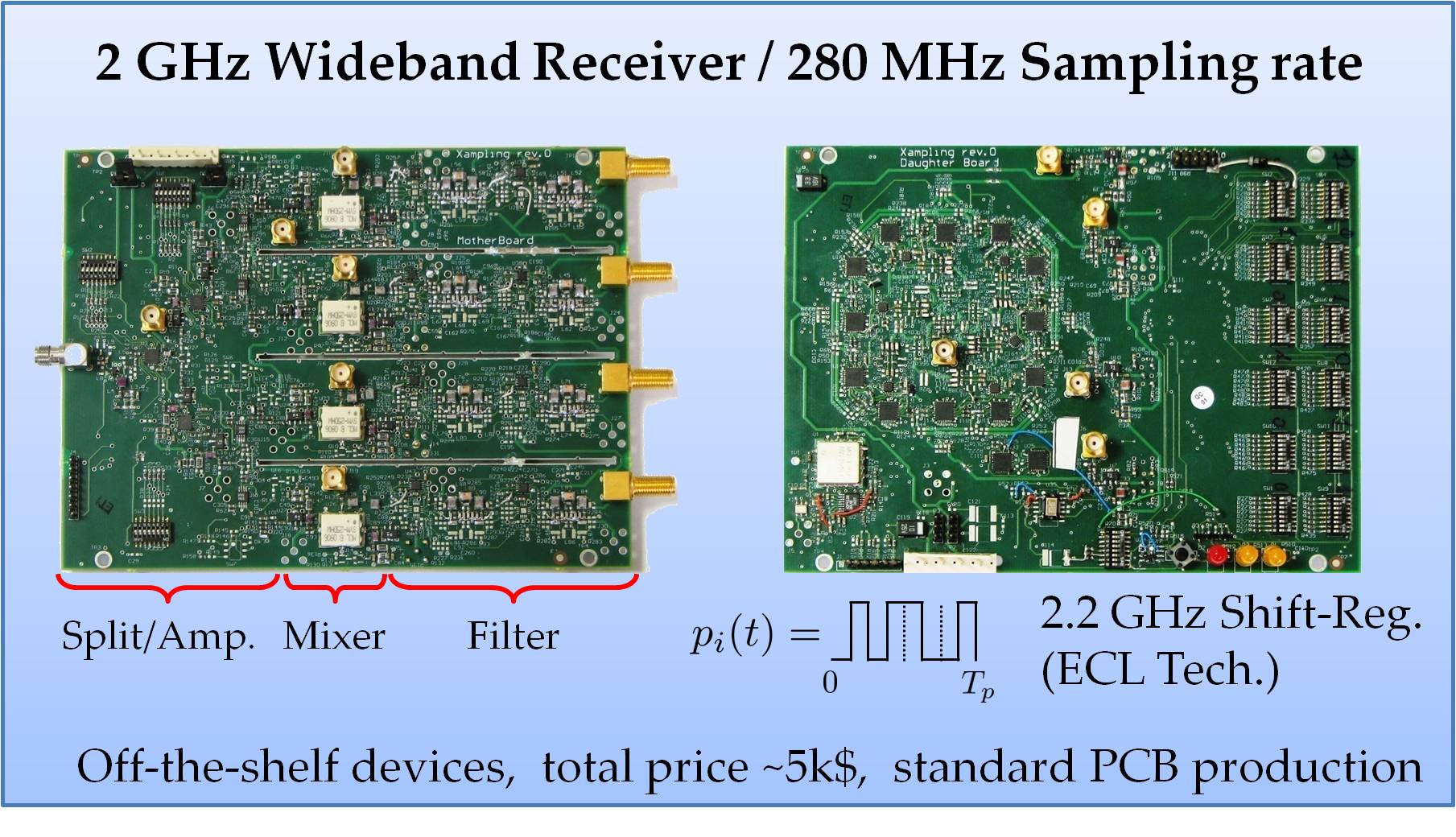
More details and documentation are available online here.
References
- M. Mishali and Y. C. Eldar, "Wideband Spectrum Sensing at Sub-Nyquist Rates", IEEE Signal Processing Magazine, vol. 28, no. 4, pp. 102-135, July 2011.
- M. Mishali and Y. C. Eldar, "Blind
Multi-Band Signal Reconstruction: Compressed Sensing for
Analog Signals", IEEE Trans. on Signal Processing, vol.
57, no. 3, pp. 993-1009, March 2009.
- M. Mishali and Y. C. Eldar, "Reduce
and Boost: Recovering Arbitrary Sets of Jointly Sparse
Vectors", IEEE Trans. on Signal Processing, vol. 56, no.
10, pp. 4692-4702 , October 2008.
- M. Mishali and Y. C. Eldar, "From
Theory to Practice: Sub-Nyquist Sampling of Sparse Wideband
Analog Signals", IEEE Journal of Selected Topics on
Signal Processing, vol. 4, no. 2, pp. 375-391, April 2010.
- M. Mishali, Y. C. Eldar, O. Dounaevsky
and E. Shoshan, "Xampling: Analog to Digital at Sub-Nyquist Rates", IET Circuits, Devices & Systems, vol. 5, no. 1, pp. 8–20, Jan. 2011.
Software Packages
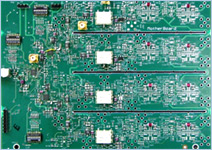 Sub-Nyquist Sampling: The Modulated Wideband Converter Sub-Nyquist Sampling: The Modulated Wideband Converter
Simulation package of sub-Nyquist sampling and support recovery using the modulated wideband converter (MWC). This page describes the MWC design, the Matlab code, and offers two software packages: analog and digital versions. The former simulates the samples that would have been obtained by true hardware. The latter provides a digital approximation of the MWC. The analog simulations consume more time but are more accurate.
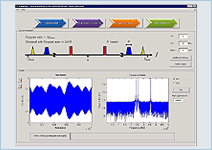 Graphical User Interface for The Modulated Wideband Converter Graphical User Interface for The Modulated Wideband Converter
A GUI package written in Matlab that provides a user-friendly introduction of the MWC. The GUI environment guides the user through 4 steps: building a multiband model, configuring the MWC and sub-Nyquist sampling, support recovery using the continuous-to-finite (CTF) block, and finally continuous reconstruction.
-
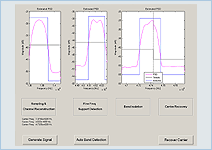 Carrier Frequency Recovery from Sub-Nyquist Samples Carrier Frequency Recovery from Sub-Nyquist Samples
The modulated wideband converter (MWC) enables sub-Nyquist sampling of narrowband transmissions, when their carrier frequencies are unknown to the sampler. Reconstruction from the MWC sub-Nyquist samples is demonstrated in the package above. This GUI package provides signal processing of the narrowband transmissions by estimating the carrier frequencies from the lowrate samples. It also recovers the information bits that are encoded in the narrowband transmission of interest.
|
|
 |
Copyright © 2010 Professor Yonina Eldar. All Rights Reserved. |
|
